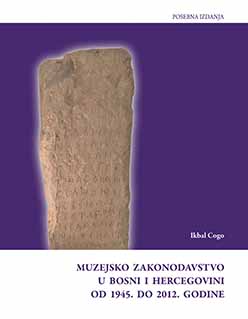Muzejsko zakonodavstvo u Bosni i Hercegovini od 1945. do 2012. godine
Museum Legislative in Bosnia and Herzegovina 1945 - 2012.
Author(s): Ikbal Cogo
Subject(s): Law, Constitution, Jurisprudence, Museology & Heritage Studies, Library and Information Science
Published by: Muzej grada Zenice
Keywords: Law on museums;Bosnia and Herzegovina;museum; 1945-2012;
Summary/Abstract: The scientific and professional literature in Bosnia and Herzegovina has not considered the issue of legislation on museums to a great extent during the past decades. Although tens of museums and galleries on the territory of Bosnia and Herzegovina actively work (the first museum collection was established in 1884 in Humac near Ljubuški, and the first public museum institution – the National Museum was founded in 1888 in Sarajevo), legislation apparently seems not to have been an interesting issue for research and analysis.
During the period of the Kingdom of Serbs, Croats and Slovenes/the Kingdom of Yugoslavia (1918-1941) the common legal act on museums did not exist although it was drafted on several occasions. In those days, there were two public museums in Bosnia and Herzegovina (the above-mentioned National Museum in Sarajevo and the Museum of Vrbas Province in Banja Luka founded in 1930) and the management staff of these museums was appointed by the Ministry of Education in Belgrade.
The first law on museum activities was adopted in Bosnia and Herzegovina after the World War II (1947) which made Bosnia and Herzegovina the first republic in Yugoslavia have such a legal act (Macedonia passed its own law in 1948 and Serbia in 1951).
Before passing the Law on Museums (which contained 6 articles), the Decision on Protection of Cultural Monuments was made in February 1945 in Belgrade. It was signed by Marshall Tito and it was binding for the entire country.
The amendments to the first Law on Museums were adopted in 1948. During 1960 a new, and much more extensive law on museums was passed and it contained 52 articles (during 1960s all the republics of former Yugoslavia passed their own laws on museums some of which for the first time such as Croatia, for instance).
The laws were passed by the Assembly upon the proposal of the Government and the Ministry in charge. The last amendments to the law on museums in Bosnia and Herzegovina before 1992 were passed in 1987. During the recent war (1992-1995) the legally binding Regulation on Museums dating from 1993 was in force. After Dayton Peace Agreement had been signed in Paris in 1995, the state of Bosnia and Herzegovina ceased being in charge of science, education and culture on the basis of Annex IV (which makes the Constitution of Bosnia and Herzegovina). This means that the field of cultural activities became the responsibility of the entity of Republika Srpska and the cantons in the Federation of Bosnia and Herzegovina. The issue of museum activities was regulated in Republika Srpska by the law and the respective by-laws while in the Federation of Bosnia and Herzegovina several cantons have legally stipulated museum activities by the corresponding laws (e.g. Canton Sarajevo in 2000, Zenica-Doboj Canton in 2003, Tuzla Canton in 2002, Bihac in 2001 and West Herzegovina Canton in 2009).
It is interesting to note that Bosnia and Herzegovina has never had the legally regulated central museum institution (there used to exist “central“ museum institutions for certain fields such as archaeology, ethnology or history) nor have there been any common standards or norms for the museum activities (to provide the required minimal space for storing, library, the defined minimal smaller or larger space as the standard for the museum institutions etc.).
It is particularly interesting that even nowadays Bosnia and Herzegovina does not have the museum of technology, traffic and the like, and, thus, there is no legal regulation to define such exhibits within the field of museum activities. Th ere is no Technical Museum (traffic, railway, post etc.) which is, nowadays, normally present in the European museum practice.
Presently, this kind of legislation exists in Republika Srpska according to which the Museum of Republika Srpska and the Museum of Modern Arts of Republika Srpska represent the central museum institutions in that entity.
They have also adopted the norms and standards for museum activities.
- Print-ISBN-13: 978-9958-0985-5-0
- Page Count: 244
- Publication Year: 2016
- Language: Bosnian
- Table of Content
- Introduction
- eBook-PDF

